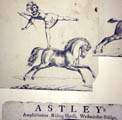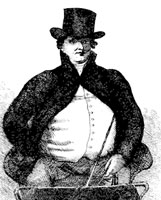|
Philip Astley in 1768 started a form of entertainment that is known throughout the world as the circus. Astley, a British equestrian, taught riding in the mornings and gave performances demonstrating his riding skills in the afternoon. He performed in a circular arena allowing the audiences better visibility of his performance. Although Astley was not the first to use the ring as a performance space, he found that working in a circle not only allowed the audience a better sight lines for his performance, it also gave him better balance using centrifugal and centripetal forces. Astley’s original performance ring was about 62 feet in diameter. Astley eventually used a 42-foot ring, which is the international standard for all circus rings today.
By 1770, Astley added acrobats, jugglers and ropedancers interspersed between his equestrian displays. Astley also borrowed a character from the Elizabethan Theatre, the clown, to fill-in between acts with parodies of rope dancing, juggling, tumbling and trick-riding. With the combination of these elements and equestrian displays, the modern circus was born.
In 1772, Astley traveled to France to perform before King Louis XV at Fontainebleau. Astley returned to Paris in 1782 to open an amphitheatre at Rue du Faubourg du Temple. In 1793, Astley left Paris due to the French Revolution. His circus was taken over by an Italian, Antonio Franconi (1737-1836). With the arrival of Napoleon and the Empire in 1802, Astley regained control of his circus in Paris. Astley has been credited for building at least nineteen permanent circus structures.
|






